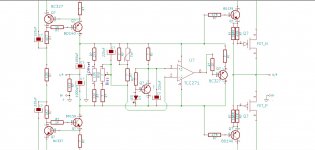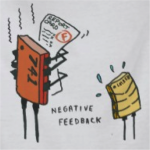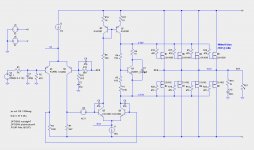Itsmee,
The GLED431 is a excellent circuit especially as a voltage reference for a current source. , 1/100 the noise of a TL431. 🙂
Jam
The GLED431 is a excellent circuit especially as a voltage reference for a current source. , 1/100 the noise of a TL431. 🙂
Jam
Thanks, I think I got enough to examine further with measurement, hopefully I'd eventually find a way to null or alleviate the compression....This effect is more apparent in orchestral climaxes, you can still detect it during low level passages.....while it does not sound bad it makes the music sound more polite for want of a better word to describe it's effects. There was also the issue of stability...
Last edited:
Ditto, been thinking about Jung's GLED431 + opamp, add a shunt output transistor, make R2 & R4 adjustable, temp stability wouldn't an issue, a thermistor is needed anyway.
I’ve been thinking of trying it out on a lateral mosfet output stage, so no thermistor would be required.
The main reason is I can use any type of capacitor value at input without worrying about stability issues.
I know I probably shouldn’t worry so much about using electrolytic capacitors but my intention is zero feedback or 6dB at most on the output stage, so I’d prefer using Low value polypropylene caps and not have to worry about potential instability problems of using TLV431.
I'm still following this thread with some interest. I have matched triplets of the lateral Mosfets used in the old Hafler amps (2SK134, 2SJ49). The latest six-pack schematic looks suitable for scaling back to three pair of output devices. I'm hoping that the lower rail voltage will help me stay within the thermal capacity of the Hafler heatsinks and chassis. Original power rails were +/– 63V for the P230, which will probably be the donor.
Edit:
Scratch the idea of using the Hafler heat sinks. They are too small to get reasonable power output.
Edit:
Scratch the idea of using the Hafler heat sinks. They are too small to get reasonable power output.
Last edited:
Oooof. The laterals have considerably lower power dissipation than the verticals I'm using in Beefcake. So my dead-short survivability was nothing of the sort.
I've fixed it in the usual way. Don't say you didn't see this coming.... 😀

Note that now that we're up to 6 pairs matching is going to be much more difficult. As a consequence I've added source resistors. (Sigh.)
Cheers,
Jeff.
I've fixed it in the usual way. Don't say you didn't see this coming.... 😀
Note that now that we're up to 6 pairs matching is going to be much more difficult. As a consequence I've added source resistors. (Sigh.)
Cheers,
Jeff.
.... The latest six-pack schematic looks suitable for scaling back to three pair of output devices.
I think that design works well with two caveats:
1) requires a large stereo chassis
2) will require a new set of laterals if you accidentally short the output
(Note that because it has no source resistors if you electrically isolate each channel heatsink you can dispense of the mica under the laterals, lowering their die temp a non-trivial amount.)
Oooof. The laterals have considerably lower power dissipation than the verticals I'm using in Beefcake. So my dead-short survivability was nothing of the sort.
I've fixed it in the usual way. Don't say you didn't see this coming.... 😀

Note that now that we're up to 6 pairs matching is going to be much more difficult. As a consequence I've added source resistors. (Sigh.)
Cheers,
Jeff.
You could buy double die lateral mosfets.
http://www.exicon.info/PDFs/ecw20n20-z.pdf
Don’t add source resistors until you’ve actually done your matching, you still may not need it, and only apply the bare minimum for your matched devices.
These are the benefits of diy - Designing a formula 1 car vs a Toyota Camry.
Last edited:
...6 pairs matching is going to be much more difficult...
That's the reason I went the puck route 🙂
I already have the laterals, so double-die and pucks are out. However, pico makes a good point that I should measure them first. Maybe matching will be easy....
...my intention is zero feedback or 6dB at most on the output stage...
I tried 6dB, I prefer it without.
I still prefer feedback but I am in agreement that 6db can sound worse. We should allow the option to operate the final design to operate with a nd without feedback.
Non-feedback amplifiers do not perform as well with low impedance and reactive loads.
I believe John Lindsey Hood has a good article about distortion vs. the amount of feedback used.
Jam
Non-feedback amplifiers do not perform as well with low impedance and reactive loads.
I believe John Lindsey Hood has a good article about distortion vs. the amount of feedback used.
Jam
Attachments
I have stabilised the Hitachi topology, at least in SPICE.
Now here's the really interesting bit: it has the same distortion spec (0.0006%) at 1W as it does at 100W (and at 200W into 4ohms).
But it's still terrible at 10kHz (1.4% @1W). Even more oddly, it actually drops at 100W (0.9%). 😕
Now here's the really interesting bit: it has the same distortion spec (0.0006%) at 1W as it does at 100W (and at 200W into 4ohms).
But it's still terrible at 10kHz (1.4% @1W). Even more oddly, it actually drops at 100W (0.9%). 😕
Attachments
I still prefer feedback but I am in agreement that 6db can sound worse....
The spectral growth distortion argument certainly has it that you should either use no feedback or a lot of it....
It just occurred to me that SixPack's OS now looks enough like Beefcake's to use the same output boards:

It would be good if mosfet spacing is 40mm to be compatible with the Store predrilled heatsinks. Saves people having to drill and tap new holes
I have stabilised the Hitachi topology, at least in SPICE.
Now here's the really interesting bit: it has the same distortion spec (0.0006%) at 1W as it does at 100W (and at 200W into 4ohms).
But it's still terrible at 10kHz (1.4% @1W). Even more oddly, it actually drops at 100W (0.9%). 😕
I think it would be preferable to use P Channel Jfets at Input. Just cascode with bipolars if you want to go over 25V rails.
You should be able to get rid of C2 in feedback loop.
Last edited:
- Home
- Amplifiers
- Pass Labs
- JamJar: an HPA-1-inspired power amp




